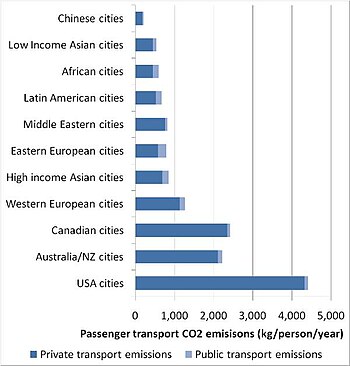Also discussed here: The Bridging the Gap Factsheets - Climate Finance – Opportunities and Challenges for Transport (6 page pdf, Bridging the Gap Initiative, Oct, 2012)
Today we review an early release of a report that covers the role of the transportation sector in addressing climate change one year ahead of decisions in the fall of 2015 at the U.N. Investment in and application of a number of measures, including both technology and personal behaviour change, could reduce energy demand by over 50% below the internationally accepted goal of keeping climate warming below 4 degrees C and also produce co-benefits to reduce traffic congestion world-wide (which has a cost as high as 10% GDP).

Key Quotes:
“Transport in total currently accounts for about 23% of global energy-related greenhouse gas emissions of which 75% are derived from land transport.” “a combination of technological and behavioural measures could decrease final energy demand in 2050 for urban passenger transport by at least 55% below an IEA defined baseline of a 4o Celsius temperature increase scenario”
“so-called co-benefits address areas that are of much more pressing concern to decision makers ..Traffic congestion and increased travel time in particular negatively impact development and are a major cost. This varies from 1.2% of GDP in the UK… 3.4% of GDP in Dakar, Senegal, 4% in Manila, Philippines .. 3.3%-5.3% of GDP in Beijing..1%-6% of GDP in Bangkok…10% of GDP in Lima, Peru where travel can consume up to four hours daily”
“A shift towards low-carbon mobility could potentially result in savings of up $100 trillion in public and private spending on transportation vehicle and infrastructure and vehicle capital and operating costs along with fuel costs, primarily from a reduction in road construction requirements and vehicle purchase requirements.”
“Averaged across all world regions, urban light-duty vehicle travel (VKT) is cut by 50% in 2050 from the Baseline to the High Shift scenario…The goal of replacing the reduced car travel with high quality transit and safe non-motorized modes … appears achievable in every part of the developing world and is only problematic in some OECD countries, particularly car-dominated countries like the United States.”
“land transport is well represented in the September 23 Climate Summit with 5 initiatives under three Action Areas: Transport (electric mobility, railways and public transport); Energy (fuel economy) and Petroleum and Industry (green freight). These initiatives have created the largest momentum for low carbon transport in the transport industry so far.”



















































